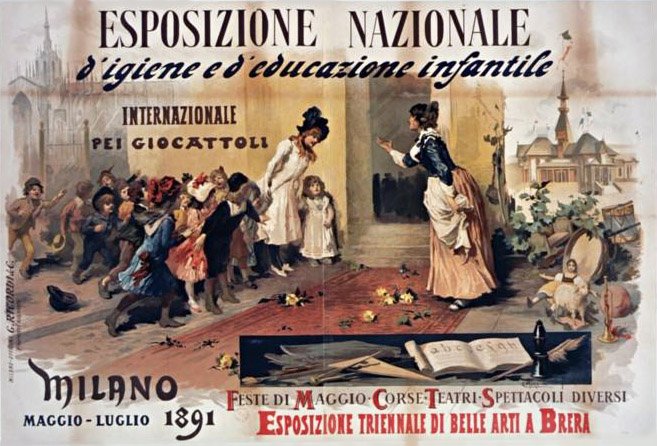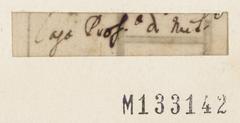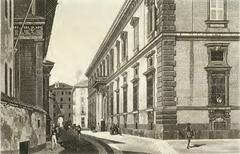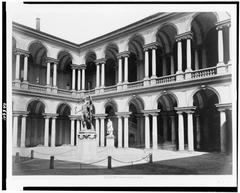
Palazzo Brera Milan: Visiting Hours, Tickets, and Historical Sites Guide
Date: 14/06/2025
Introduction: Milan’s Cultural Crown Jewel
Nestled in the heart of Milan’s Brera district, Palazzo Brera stands as a monumental testament to Italy’s enduring spirit of art, science, and innovation. This neoclassical palace is best known as the home of the renowned Pinacoteca di Brera, one of Italy’s premier art galleries, but it is much more—a vibrant cultural hub that includes the Accademia di Belle Arti di Brera, the Biblioteca Nazionale Braidense, the Osservatorio Astronomico di Brera, and the tranquil Orto Botanico di Brera. Together, these institutions make Palazzo Brera a nexus of Milanese intellectual and artistic life (Palazzo Brera website, Hidden Architecture, Britannica).
This guide provides a detailed overview of Palazzo Brera’s rich history, architectural highlights, visitor information, and practical tips to help you make the most of your visit. Whether you are captivated by Renaissance masterpieces, intrigued by Enlightenment history, or simply seeking an inspiring destination in Milan, Palazzo Brera promises a memorable experience.
Quick Facts for Visitors
- Location: Via Brera, 28, 20121 Milan, Italy
- Opening Hours: Tuesday–Sunday, 8:30 AM – 7:15 PM (last entry 6:40 PM); closed Mondays
- Tickets: Standard adult €15; reduced €10 (EU citizens 18–25, students, seniors); free for children under 18 and on the first Sunday of the month
- [Official Website: Pinacoteca di Brera](#official-website:-pinacoteca-di-brera)
- Accessibility: Fully accessible for visitors with reduced mobility
- Getting There: Metro Lanza (M2), trams 1/2/4/12/14, and several bus routes. Public transport is recommended due to limited parking.
Historical Overview
Medieval Origins
The Palazzo Brera site dates to medieval Milan, initially owned by Guercio da Baggio and later given to the Humiliati religious order, who established the church of Santa Maria in Brera in the 12th century. This church, notable for its Gothic portal by Giovanni di Balduccio and frescoes by Giovanni da Milano and others, was demolished in the 19th century (Hidden Architecture).
Jesuit Transformation
In 1572, the Jesuits transformed the complex into a college. Under architect Francesco Maria Ricchino, the palace underwent significant Baroque renovations, integrating educational and scientific pursuits, including a botanical garden and observatory (Britannica).
Habsburg and Enlightenment Era
Following the Jesuits’ suppression in 1773, the palace came under Habsburg control. Architect Giuseppe Piermarini completed the neoclassical courtyard and entrance by 1780. The site became a center for Enlightenment thought, housing the Accademia di Belle Arti and Biblioteca Nazionale Braidense (Hidden Architecture).
Napoleonic and Modern Expansion
During the Napoleonic era, the church was deconsecrated, and the Pinacoteca di Brera was established in 1809, displaying confiscated artworks. Throughout the 19th and 20th centuries, the complex expanded to include the Orto Botanico, the Osservatorio Astronomico, and advanced restoration laboratories, affirming its status as a leader in arts and sciences (Itinerary Expert).
The Institutions of Palazzo Brera
Pinacoteca di Brera: Artistic Masterpieces
The Pinacoteca di Brera is a must-visit for art lovers, housing over 400 works from the 13th to 20th centuries. Highlights include:
- Raphael’s “The Marriage of the Virgin”
- Caravaggio’s “Supper at Emmaus”
- Mantegna’s “Dead Christ”
- Piero della Francesca’s “Brera Madonna”
- Francesco Hayez’s “The Kiss”
- Works by Bellini, Titian, Tintoretto, Veronese, Rubens, and Van Dyck
The gallery is organized chronologically and thematically, enhanced by informative labels and digital guides (The Geographical Cure, World by Isa).
Accademia di Belle Arti di Brera
Founded in 1776, this academy is one of Italy’s oldest and most prestigious art schools, nurturing generations of renowned artists and designers (Brera Academy, Milano Explorer).
Biblioteca Nazionale Braidense
Established in 1786, the Braidense Library boasts over 1.5 million volumes in elegant neoclassical reading rooms, serving as a vital resource for scholars and bibliophiles (Italia.it).
Orto Botanico di Brera
This 18th-century botanical garden is a green oasis with over 300 plant species, including rare medicinal herbs. Open to visitors, it offers guided tours and educational workshops (Orto Botanico di Brera).
Osservatorio Astronomico di Brera
A center of astronomical research and history, the observatory displays historical instruments and offers tours during special events (Brera Observatory).
Palazzo Citterio and the Grande Brera Project
The 2024 opening of Palazzo Citterio as part of the Grande Brera initiative has expanded the Pinacoteca’s modern and contemporary art collection, featuring works by Boccioni, Modigliani, Picasso, and Carrà (Grande Brera, Goppion).
Architectural and Artistic Highlights
Admire the palace’s blend of Baroque and Neoclassical styles, especially Piermarini’s grand courtyard with the bronze statue of Napoleon as Mars the Peacemaker by Antonio Canova. The palace interior is filled with period frescoes, marble staircases, and ornate halls that set the stage for the masterpieces within (Itinerary Expert).
Visitor Experience and Practical Tips
Tickets and Admission
- Pinacoteca di Brera: €15 (standard), €10 (reduced), free for children under 18 and on the first Sunday of each month
- Combined tickets: Available for access to multiple Brera institutions and Palazzo Citterio
- Where to buy: Official ticket portal; advance booking recommended, especially during events or free days
Guided Tours and Audio Guides
- Multilingual guided tours; audio guides and downloadable materials available
- Workshops and family activities held regularly (Pinacoteca di Brera)
Accessibility
- Elevators, ramps, and accessible restrooms are available throughout the complex (urbanfile.org)
- Staff are trained to assist guests with disabilities
Facilities
- Cloakroom for bags and coats (check for closures during special events)
- Bookshop with art books and souvenirs
- No on-site café, but the Brera district offers numerous dining options
Dress Code and Etiquette
- Dress respectfully; large bags may be checked at the cloakroom
- Photography without flash is generally permitted; restrictions apply for some exhibitions
- Remain quiet and refrain from touching artworks
Getting There
- Metro: Lanza (M2), Montenapoleone (M3), Cairoli (M1)
- Tram/Bus: Lines 1, 2, 4, 12, 14, and several buses stop nearby
- Parking: Limited; public transport or nearby garages recommended
Special Events and Seasonal Highlights
- Design Week (Fuorisalone): Palazzo Brera is a hub for immersive installations and contemporary exhibitions (Design Pataki)
- Free Entry Days: First Sunday of each month
- Temporary Exhibitions: Regularly rotating displays and contemporary art shows
- Workshops: For families and children, especially during school holidays
Explore the Brera District
The surrounding Brera district is known for its bohemian charm, art galleries, boutique shops, and vibrant café culture. Don’t miss the Antique Market (third Sunday each month), independent galleries, and local trattorias (Barcelo).
Frequently Asked Questions (FAQ)
Q: What are the opening hours of Palazzo Brera?
A: Tuesday–Sunday, 8:30 AM–7:15 PM; closed Mondays.
Q: How much do tickets cost?
A: €15 standard, €10 reduced, free for children under 18 and on the first Sunday of each month.
Q: Is the site wheelchair accessible?
A: Yes, with ramps, elevators, and accessible restrooms.
Q: Can I take photos inside?
A: Photography without flash is generally permitted except for some temporary exhibitions.
Q: Are guided tours available?
A: Yes, in multiple languages; book online in advance.
Q: What else is there to see nearby?
A: Brera district boutiques, Sforza Castle, Milan Cathedral, La Scala, and the Orto Botanico di Brera.
Visuals and Media Recommendations
Enhance your visit with virtual tours and image galleries on the Pinacoteca di Brera website. Recommended alt tags include “Palazzo Brera Milan exterior,” “Renaissance art at Pinacoteca di Brera,” and “Courtyard of Palazzo Brera.” For interactive planning, consult digital maps available online.
Summary and Final Tips
Palazzo Brera is a must-see for anyone visiting Milan, offering a harmonious blend of art, history, and innovation. To ensure a seamless experience:
- Book tickets in advance—especially for free entry days and major exhibitions.
- Use audio guides or the Audiala mobile app for deeper engagement.
- Explore the vibrant Brera neighborhood for a full day of discovery.
- Check the official website for current exhibitions and event updates.
For a truly enriching visit, plan ahead and immerse yourself in one of Milan’s greatest cultural treasures.
References and Further Reading
- Palazzo Brera, Hidden Architecture
- Pinacoteca di Brera, Official Site
- Palazzo di Brera, Britannica
- Pinacoteca di Brera Guide, Itinerary Expert
- Grande Brera Initiative, Goppion
- Brera Academy
- Brera Observatory
- Orto Botanico di Brera
- Milan Tourism, YesMilano
- Voyaged Magazine
- Design Pataki
- Barcelo Guide to Brera
- The Geographical Cure
- World by Isa
- Savoring Italy
- Brera Design District
- Wanted in Milan
- Urbanfile
- Ready Set Italy
- MominItaly
- The Travel Folk






























































